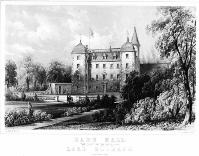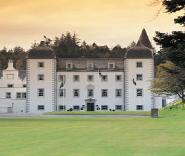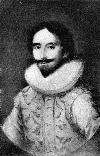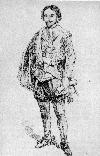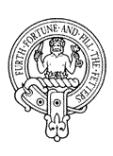See also
- John MURRAY's father: Andrew MURRAY ( -1485)
John MURRAY ( -1513)
1. John MURRAY, son of Andrew MURRAY ( -1485), died on 9 September 1513. He married Isobel HOPPAR.
...of Blackbarony. Descended from Roger de Morref, son of Erchebaud. The estate of Blackbarony came to the family when the then owner alienated part of the lands without the licence of the Crown. Under the great seal the lands were vested in John Murray and his wife Isobel Hoppar.
Burgess of Edinburgh. Descended from Roger de Morref, son of Erchebaud. He held the lands of Philiphaugh in Selkirkshire under charter of the Great Seal. He was Queen's Herdsman of Ettrick Forest and Keeper of Newark Castle. He had seven sons, the eldest of whom, Patrick, being the founder of the Murrays of Philiphaugh, Deuchar, Skikling, Melgum and Bowhill. On the 5th September 1511 he acquired Ballencrief,Haddington. He was killed at Flodden on 9th September 1513.
He was Queen's Herdsman of Ettrick Forest and Keeper of Newark Castle. He had seven sons, the eldest of whom, Patrick, being the founder of the Murrays of Philiphaugh, Deuchar, Skikling, Melgum and Bowhill. On the 5th September 1511 he acquired Ballencrief,Haddington. He was killed, like so many of his compatriots, at the Battle of Flodden on 9th September 1513.
Isobel HOPPAR and John MURRAY had the following children:
| +2 | |
| +3 | |
| +4 |
Second Generation
2. Sir Andrew MURRAY, son of John MURRAY and Isobel HOPPAR, married Elizabeth LOCKHART circa [Julian] 14 June 1533. He married Grissel SCOTT (NEE BETHUNE) on 8 February 1551. He died on 1 September 1572.
Became ... of Blackbarony. Was a zealous Protestant. He had two sisters.
On his residence, Darn Hall -
"GHOST HUNT AT BARONY CASTLE, SCOTTISH BORDERS"
Built in 1536, this stunning manor house is set in 25 acres of woodland, complete with amazing views of the Tweed Valley. It is now a luxurious hotel and conferencing venue owned by Devere Venues.
The history of Barony Castle is frustratingly hazy. Believed to have been commissioned by Sir Andrew Murray, it was initially built as a border tower. It later served as a family home for many years for the Murrays, an influential family in Scottish history. Originally known as Darn Hall, it is sometimes also referred to as Black Barony Castle. An old illustration can be seen on the right, depicting Darn Hall from several hundred years ago.
John Murray, son of Andrew, was responsible for enclosing the lands and developing the property into a mansion. According to records, John was knighted on the spot after announcing to King James VI (James I of England, who would later be the target of the Gunpowder Plot) the birth of his first son, Henry, Prince of Wales.
Sir Andrew Murray's other son, Gideon Murray, would later become Lord Elibank, firm favourite of King James VI. It appears that during his later years in politics he acted as Royal Treasurer for Scotland and as such was responsible for the repair and improvement of many Scottish Royal properties, notably Linlithgow Palace. It is unclear how much of his time was spent at Barony, as his main home was at nearby Elibank Castle, the ruins of which can still be seen today. It was there to which he fled after falling from favour with the King, after rumours of financial mismanagement meant that he was due to be put on public trial. Mortally offended, he took to his bed and went on hunger strike, dying after two weeks of refusing food and water. Ironically, after his death, James completely exonerated him from any wrongdoing.
Gideon did, however, leave one legacy. His daughter, Agnes Murray, was the subject of 'Muckle Mou'd Meg', a legend well known to any Scot! For those south of the border, this strange tale can be read here. Walter Scott, a descendant of Agnes, referred to her ghost haunting Barony Castle and witnessed it himself while staying there.
Barony Castle now holds more than a passing interest for those interested in the paranormal, for there are many curious stories of hauntings within its walls. Since it has been a hotel so many guests have reported strange goings on that a form is now left in each room for guests to fill in if they happen to experience anything out of the ordinary.
The last Murray to live in the house was Alexander Fox Murray, who sold it as a hotel in 1927. It is believed to be his apparition who appears in the Tweeddale room, as if sitting in a rocking chair and staring at the fireplace, which was bricked up in the late eighties. He ignores any witnesses and slowly fades away, accompanied by the smell of cigar smoke and brandy. Many people have seen his ghost and he is now known affectionately as 'Auld Reekie'.
].
Sir Andrew Murray was a zealous protestant. He is believed to have commissioned Barony Castle (originally Darn Hall), which later served as a family home for many years for the Murray family.
Elizabeth LOCKHART was the daughter of William LOCKHART ( - ). She and Andrew MURRAY had the following children:
| +5 |
Grissel SCOTT (NEE BETHUNE), daughter of Sir John BEATON (2nd of Creich) ( - ) and Janet HAY ( - ), died on 18 August 1579. She and Andrew MURRAY had the following children:
| +6 | |
| +7 | |
| +8 | |
| +9 | |
| +10 | |
| +11 |
3. Agnes MURRAY was the daughter of John MURRAY and Isobel HOPPAR.
An arrangement for her marriage with Archibald Napier of Merchiston had been made (18th June 1525), but was not implemented.
4. Margaret MURRAY, daughter of John MURRAY and Isobel HOPPAR, married William LITTLE on [Julian] 26 October 1532.
William LITTLE was the son of Edward LITTLE ( - ) and Marion ADAMSON ( - ).
Third Generation
5. Marion MURRAY, daughter of Sir Andrew MURRAY and Elizabeth LOCKHART, married James PRINGLE on [Julian] 14 December 1566. She died in [Julian] May 1585 in Whitebank.
6. Sir John MURRAY of Blackbarony, son of Sir Andrew MURRAY and Grissel SCOTT (NEE BETHUNE), was a MP for Peebles. He died on 3 July 1609. He married Margaret HAMILTON. He married Margaret WAUCHOPE.
... of Blackbarony. John was knighted at Stirling on announcing to King James VI the birth of his eldest son Henry, Prince of Wales. He was mainly responsible for enclosing the lands at Darn Hall and developing the property from a border tower to a mansion.
7. Andrew MURRAY, son of Sir Andrew MURRAY and Grissel SCOTT (NEE BETHUNE), died before [Julian] 2 June 1587.
8. Sir Gideon MURRAY, son of Sir Andrew MURRAY and Grissel SCOTT (NEE BETHUNE), was born on 1 January 1559. He had the title 'Lord Elibank'. He was a MP for Selkirk, Treasurer-Depute for Scotland. He died on 29 June 1621. He married Margaret PENTLAND.
Sir Gideon Murray of Elibank, politician and judge, was the third son of Sir Andrew Murray of Blackbarony, Peebleshire, and Grisel Bethune, daughter of Sir John Bethune of Criech in Fife and widow of William Scott of Buccleuch.
Murray attended the University of Glasgow, from which he graduated with an MA in 1581. Soon afterwards he entered the ministry as minster of the parsih of Auchterless in Aberdeenshire. His career in the church was however cut short by Murray's killing of a man named Atchison in 1585, for which crime he was imprisoned in Edinburgh Castle. The Countess of Arran, wife of James Stewart, Earl of Arran, who effectively governed Scotland from 1583 to 1585, intervened on his behalf, and, as a result he was released on the order of James VI on 20th May 1585. The document signed by the King still exists. Murray then entered the service of his nephew Walter Scott of Buccleuch as chamberlain of his estates. In June 1587 he entered into an "irregular marriage" with Margaret, daughter of Dionysius Pentland, an Edinburgh miller. Margaret later took the matter to court to legitimize the relationship and the status of their three children.
During his time with the laird of Buccleuch Murray travelled to the continent as far as Italy. When he returned he became involved in a border feud: Murray's master, Scott of Buccleuch, as the laird of Johnstone's uncle, was drawn into the long-running feud between the Maxwells and Johnstones, which culminated, on 7 December 1593, with Murray leading 500 Scotts against the Johnstones at the battle of Dryfe Sands at which Lord Maxwell was killed.
Murray was first recorded in crown service in July 1592 when he was given a commission by the privy council to demolish certain houses belonging to Walter Scott of Harden (Auld Wat, a famous border riever or raider). Scott had been involved with "the lait tressonable fact perpetrat aganis his Hienes awne persone at Falkland" when Francis Stewart, Earl of Bothwell, made one of his characteristically unorthodox attemps to gain an audience with the king by forcing an entry into the royal palace in Fife. In March 1595 Murray was granted the lands of Elibank in Selkirkshire, which were erected into a barony in September 1601, thus giving him his designation as laird of Elibank. In October 1602 he was one of the border landlaords who subscribed the king's "general band" against thieves, murderers, and oppressors in the borders. This region had been notoriously ungovernable for a long time, and James VI was determined, especially when he also assumed the throne of England, to wipe out lawlessness, and the border region was his principal target: he soon came to appreciate Murray's skills and ruthlessness in this task. Murray was then appointed a border commissioner, whose autonomy in bringing offenders and potential offenders to justice was almost absolute, but extreme situations require extreme remedies, it would have been said. Gideon was knighted for his services on 4 March 1605 and in August 1607 was appointed to a new border commission under the earls of Dunbar and Cumberland, for which he received payment of ?00. Murray's steady rise to power came at the same time as James VI's consolidation of his own authority, and it seems that he was several times awarded the land and estates of those he had caused to be punished.
In 1610 he was admitted to the privy council, appointed a commissioner for the exchequer, and received further money from the crown, through the offices of the earl of Dunbar, in the form of an annual pension of ?200. This was confirmed by Parliament in October 1612 where Murray sat for the first time as a shire commissioner for Selkirkshire. At this meeting he was also elected as one of the lords of the articles, the business committee for receiving petitions and drafting legislation.
In November 1613 Murray became an ordinary Lord of Session, taking the title Lord Elibank. In 1614 he became embroiled in the politics of the church, where he was involved in the arrest and execution for treason of the Jesuit Missionary John Ogilvie. His involvement in religious matters continued in 1615 when he was appointed a member of the unified court of high commission, the supreme court in all matters of ecclesiastical discipline throughout Scotland, under John Spottiswoode, Archbishop of St. Andrews. As a Lord of Session he was also appointed to a commission of justiciary for the north in 1616. As a result of taking on this wide array of duties for the crown his annual pension was augmented to ?400 and he was granted, for the duration of his life and that of his sons, the right to import 30 tuns of wine duty free!
Having been appointed one of the "New Octavians" in April 1611 to manage the royal finances in Scotland, in November 1612 Elibank was given the offices of treasurer-depute, comptroller, and collector-depute of the new ecclesiastical lands with an annual salary of ?500. The Lord High Treasurer in Scotland was his cousin Robert Ker of Ferniehirst, Earl of Somerset, the seemingly untouchable favourite of the King. Ker treated his office as an honourary one and, as a result, Elibank appears to have acted as de facto Royal Treasurer in Scotland. In this capacity he was instrumental in seeing to the repairing and enhancing of a number of royal properties in Scotland-notably in the reconstruction after its collapse of the north range at Linlithgow Palace in 1617 in the new Scottish Renaissance style. In the summer of the same year he also successfully oversaw the financing of James VI's only visit to Scotland subsequent to the regal union.
King James was so pleased with his good services to the crown that he became very fond of Elibank. On a visit by him to court, James is said to have bent down to pick up a glove which the Treasurer-Depute had dropped, saying that "My predecessor, Queen Elizabeth, thought she did a favour to any man who was speaking with her when she let her glove fall, that he might take it up and give it her again; but, sir, you may say a king lifted up your glove".
Elibank was suddenly to fall from favour in 1621, when "calumnies" were spread about him at court by Sir James Stewart (the same Sir James Stewart whom Murray had much earlier questioned about expenses claimed from the crown, for which he had not forgiven the latter) who alleged that he had been involved in financial mismanagement. Elibank was summoned to London, and then told to go back to Scotland to await trial. It is not known whether King James had organized the trial in order publicly to exonerate Elibank, or whether he felt that he had become too powerful, but in any case, he was mortally offended, took to his bed, and for two weeks refused to take food or drink, at the end of which period he died.
Afterwards, the King issued documents clearing Elibank of any blame whatsoever, and, in recognition of his achievments and loyalty to the crown, raised his son Patrick to the peerage as Lord Elibank: this was hereditary - Gideon Murray's title was not. The king's letter, under the Great Seal, said:
"making mention that His Majesty, calling to mind the true and faithful service done to His Majesty by Umquhile Sir Gideon Murray of Elibank, Knycht... and to make an honourable remembrance that others by his example may be moved by the like care and fidelity, and therefore His Majesty of certain right and proper motion, with advice and consent of the Lords of His Majesty's present Council, finds and decrees that said Umquhile Sir Gideon Murray... during the whole time and period thereof from his first employment to his decease behaved himself therein faithfully and diligently as became a loyal subject and dutiful servant... and declares him and his heirs free from all imputations, calumnies, or aspersions whatsoever, whereby his person, name, fame, goods, lands or posterities may in any sort be taxed, scandalised or endangered... " and, on the occasion of Sir Gideon's son Patrick being raised to the peerage some time later, when King Charles was on the throne: "... and of the many worthy services done to His Majesty, our late dearest Father, in the Council, Session and Exchequer by the late Sir Gideon Murray.
Further, the motto given to the Murrays of Elibank by King James I was "Virtute Fideque" (by courage and faithfulness).
In fact the family's fortunes did not last long, as Patrick's son, loyal also to Charles I, lent the monarch large amounts of money to prop him up, and then found himself on the wrong side during the Commonwealth.
Gideon Murray was famous for one other thing: he was the father of Agnes Murray "Muckle Mou'd Meg", the legend of which is well-known to any Scot!
It may be worth mentioning, that by warrant signed at Hitchinbroke, October 23, 1618, the king gave to Sir Gideon Murray of Elibank ‘a gilt basin which was given to us by our burgh of Edinburgh, with their propine of money, at our first entry of the said burgh, at our last being in our said kingdom; together with two gilt cups, one of them in form of a salmon, presented to us by our burgh of Glasgow; and another gilt cup which was given us by the town of Carlisle; together with some remanent of musk and ambergrise, which was unspent at our being there; and, lastly, ane large iron chest, which did sometime belong to the late Earl of Gowrie.’—An. Scot. http://www.electricscotland.com/history/domestic/vol1ch9f.htm
The history of Barony Castle is frustratingly hazy. Believed to have been commissioned by Sir Andrew Murray, it was initially built as a border tower. It later served as a family home for many years for the Murrays, an influential family in Scottish history. Originally known as Darn Hall, it is sometimes also referred to as Black Barony Castle. An old illustration can be seen on the right, depicting Darn Hall from several hundred years ago.
John Murray, son of Andrew, was responsible for enclosing the lands and developing the property into a mansion. According to records, John was knighted on the spot after announcing to King James VI (James I of England, who would later be the target of the Gunpowder Plot) the birth of his first son, Henry, Prince of Wales.
Sir Andrew Murray's other son, Gideon Murray, would later become Lord Elibank, firm favourite of King James VI. It appears that during his later years in politics he acted as Royal Treasurer for Scotland and as such was responsible for the repair and improvement of many Scottish Royal properties, notably Linlithgow Palace. It is unclear how much of his time was spent at Barony, as his main home was at nearby Elibank Castle, the ruins of which can still be seen today. It was there to which he fled after falling from favour with the King, after rumours of financial mismanagement meant that he was due to be put on public trial. Mortally offended, he took to his bed and went on hunger strike, dying after two weeks of refusing food and water. Ironically, after his death, James completely exonerated him from any wrongdoing.
Gideon did, however, leave one legacy. His daughter, Agnes Murray, was the subject of 'Muckle Mou'd Meg', a legend well known to any Scot! For those south of the border, this strange tale can be read here. Walter Scott, a descendant of Agnes, referred to her ghost haunting Barony Castle and witnessed it himself while staying there.
Barony Castle now holds more than a passing interest for those interested in the paranormal, for there are many curious stories of hauntings within its walls. Since it has been a hotel so many guests have reported strange goings on that a form is now left in each room for guests to fill in if they happen to experience anything out of the ordinary. http://www.eerie-evenings.com/Barony%20Castle%20Main.htm.
Margaret PENTLAND was the daughter of Dionysius PENTLAND ( - ). She and Gideon MURRAY had the following children:
| 12 | William MURRAY (1601-1664). William was born on 4 June 1601. He died on 24 May 1664 in Edinburgh. |
| 13 | Walter MURRAY (1601-1659). Walter was born on 4 June 1601. He died on 1 January 1659. |
| 14 | Patrick 1st MURRAY (c. 1608-1648). Patrick was born circa 1608. He had the title 'Nova Scotia Baronet, Keeper of Caerlaverock, 1st Lord Elibank of Ettrick Forest'. He was a MP for Haddington. He married Margaret HAMILTON on 21 August 1610. He married Elizabeth DUNDAS on [Julian] 24 January 1617. He married Helen LINDSAY on [Julian] 16 January 1628. He married Agnes NICOLSON on 11 December 1636. He died on 12 November 1648. He was buried in "In his aisle at Aberlady Kirk, East Lothian".. He was buried in his aisle in Aberlady Kirk. |
| 15 | Agnes (Meg) MURRAY ( - ). Agnes married William SCOTT on 14 July 1611. |
9. William MURRAY, son of Sir Andrew MURRAY and Grissel SCOTT (NEE BETHUNE), married Margaret COLVILLE in 1627. He died on 25 December 1638. He married Marjorie SHAW.
... of Dunerne and Newton, ancestor of the Murrays, Baronets of Dunerne.
10. Elizabeth MURRAY, daughter of Sir Andrew MURRAY and Grissel SCOTT (NEE BETHUNE), married James BOTHWICK. She married Tomas HAMILTON.
James BOTHWICK died in [Julian] April 1574.
11. Agnes MURRAY was the daughter of Sir Andrew MURRAY and Grissel SCOTT (NEE BETHUNE).
